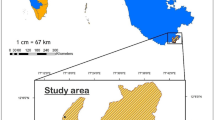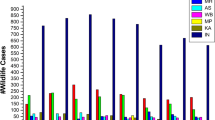Abstract
Beluga whale hunting is one of the most social subsistence hunting activities to take place in the Canadian Arctic. Through the harvest, distribution and consumption of beluga whales, Inuit identity and social relationships are affirmed. The whale-hunting complex is influenced by beliefs that beluga whales are sentient beings who inhabit a shared social space with humans. Yet, across the region beluga whales are perceived by wildlife managers as scarce resources and as such require protection through the imposition of management plans. There is currently no management of whales on the west coast of Hudson Bay, in Nunavut. In 2002, Inuit there were requested to sell part of their whale harvest to Inuit in Nunavik, northern Quebec, where hunting quotas exist. The outcome of this event was concern in Nunavut for the future of the whale hunt, and a deepening sense of powerlessness in Nunavik due to the management of the whale harvest.

Similar content being viewed by others
Notes
Maktaaq: the skin and thin layer of subcutaneous fat of the beluga whale, which is eaten by Inuit.
Arviarmiut: the people of Arviat.
Quaqtarmiut: the people of Quaqtaq.
Country food refers to all food harvested from the land and sea.
Arviarmiut have informed me that in the past people ate dried whale meat, but few in the village recall eating it themselves. I believe the far greater abundance of caribou in this region and a culture more oriented towards land mammals has led to the lesser appeal of whale meat (see Burch (1986, 1988) and Fossett (2001) for a discussion of the inland origins of west coast Hudson Bay Inuit).
See Fienup-Riordan (1990) for a detailed account of knowledge of sea birds in Alaska.
See Freeman (2005) for a discussion of “use” and “waste” of harvested beluga whales.
See Bodenhorn (2000) on kinship and the importance of food-sharing as a reaffirmation of kinship ties.
CB: Citizen Band radio, an essential communication tool while out hunting, used by Inuit throughout much of the year.
This concern possibly reflects more deeply held misperceptions concerning hunter–gatherers and the “commercialisation” of their subsistence harvest. While exchanging products of the harvest for money is not of moral concern to most Inuit, it is of concern to certain animal rights organisations and those concerned with maintaining “cultural integrity”. For more discussion on this topic, see Wenzel (1991) and Caulfield (1997).
The endangered east coast Hudson Bay whale population also migrates through Hudson Strait, but Inuit can easily distinguish between these two populations due to the timing of the migration, the size of the pods, and the size and shape of the whales.
In 2003, eight hunters in Taloyuak faced charges for killing narwhals outside of the quota set for that village. This case was widely reported by the northern media. The convicted hunters finally won their appeal in 2006. The duration and severity of this case has been a cause for concern amongst many Inuit hunters.
Once the regional quota was filled, the hunt was closed, thus denying some villages the opportunity to fill their quota.
In 2002, I conducted an interview with a DFO official who was visiting Arviat, who informed me that Inuit do not know how to hunt whales properly. He claimed that there is no history of whale hunting in the region (despite historical and archaeological evidence to the contrary), and the methods employed by Inuit were “improper”. This was the same individual who spoke at the HTO AGM about his concerns regarding the sale of maktaaq.
References
Anderson, D. G., and Berglund, E. (2003). Ethnographies of Conservation: Environmentalism and the Distribution of Privilege, Berghahn Books, New York.
Berkes, F. (2005). Commons theory for marine resource management in a complex world. In Kishigami, N. and Savelle, J. M. (eds.), Indigenous Use and Management of Marine Resources. Senri Ethnological Studies 67, The National Museum of Ethnology, Osaka, pp. 13–32.
Berkes, F., Colding, J., and Folke, C. (2000). Rediscovery of Traditional Ecological Knowledge as Adaptive Management. Ecological Applications 10(5): 1251–1262.
Bird-David, N. (1990). The Giving Environment: Another Perspective on the Economic System of Gather-hunters. Current Anthropology 31: 189–196.
Bodenhorn, B. (1990). “I’m Not the Great Hunter, My Wife Is”: Inupiat and Anthropological Models of Gender. Études/Inuit/Studies 14(1–2): 55–74.
Bodenhorn, B. (2000). “He used to be my relative”: Exploring the bases of relatedness among Inupiat of northern Alaska. In Carsten, J. (ed.), Cultures of Relatedness: New Approaches to the Study of Kinship, Cambridge University Press, Cambridge, pp. 128–148.
Brody, H. (2000). The Other Side of Eden: Hunters, Farmers and the Shaping of the World, Douglas and McIntyre, Vancouver.
Burch, E. S., Jr. (1986). The Caribou Inuit. In Morrison, R. B. and Wilson, C. R. (eds.), Native Peoples: The Canadian Experience, McClelland and Stewart, Toronto, pp. 106–133.
Burch, E. S., Jr. (1988). Knud Rasmussen and the “original” inland Eskimos of Southern Keewatin. Études/Inuit/Studies 12(1–2): 81–100.
Caulfield, R. A. (1997). Greenlanders, Whales, and Whaling: Sustainability and Self-determination in the Arctic, University Press of New England, London.
Condon, R. G., Collings, P., and Wenzel, G. (1995). The Best Part of Life: Subsistence Hunting, Ethnicity, and Economic Adaptation Among Young Adult Inuit males. Arctic 48(1): 31–46.
COSEWIC (Committee on the Status of Endangered Wildlife in Canada) (2004). COSEWIC Assessment and Update Status Report on the Beluga Whale, Delphinapterus Leucas, in Canada, COSEWIC, Ottawa.
Dahl, J. (1990). Beluga Hunting in Saqqaq. North Atlantic Studies 2(1–2): 166–170.
Dahl, J. (2000). Saqqaq: An Inuit Hunting Community in the Modern World, University of Toronto Press, Toronto.
Department of Fisheries and Oceans, Canada (2005a). Nunavik and adjacent waters beluga management plan 2005.
Department of Fisheries and Oceans, Canada (2005b). Recovery Potential Assessment of Cumberland Sound, Ungava Bay, Eastern Hudson Bay and St. Lawrence Beluga Populations (Delphinapterus leucas). DFOCan. Sci. Advis. Sec. Sci. Advis. Rep. 2005/036.
Department of Fisheries and Oceans, Canada (2005c). Underwater World: Beluga (revised edition), Communications Directorate, Fisheries and Oceans Canada, Ottawa.
Department of Fisheries and Oceans, Canada (2005d). Stock Assessment in Northern Quebec (Nunavik) Beluga (Delphinapterus leucas). DFO Can. Sci. Advis. Sec. Sci. Advis. Rep. 2005/020.
Fienup-Riordan (1988). Eye of the dance: Spiritual life of Bering Sea Eskimo. In Fitzhugh, W. W. and Crowell, A. (eds.), Crossroads of Continents: Cultures of Siberia and Alaska, Smithsonian, Washington, DC, pp. 256–270.
Fienup-Riordan (1990). “The Bird and the Bladder”: The Cosmology of Central Yup’ik Seal Hunting. Études/Inuit/Studies 14(1–2): 23–38.
Fossett, R. (2001). In Order to Live Untroubled: Inuit of the Central Arctic, 1550–1940, The University of Manitoba Press, Winnipeg.
Freeman, M. M. R. (2005). “Just one more time before I die”: Securing the relationship between Inuit and whales in the Arctic regions. In Kishigami, N. and Savelle, J. M. (eds.), Indigenous Use and Management of Marine Resources. Senri Ethnological Studies 67, The National Museum of Ethnology, Osaka, pp. 59–76.
George, J. 2005. Nunavik Coasts Face Total Bans on Beluga Hunting. http://www.nunatsiaqnews.com/news/nunavut/50422_01.html.
Guemple, L. (1986). Men and Woman, Husbands and Wives: The Role of Gender in Traditional Inuit Society. Études/Inuit/Studies 10(1–2): 9–24.
Hammill, M. O., Lesage, V., Gosselin, J.-F., Bourdages, H., de March, B. G. E., and Kingsley, M. C. S. (2004). Evidence for a Decline in Northern Quebec (Nunavik) Belugas. Arctic 57(2): 183–195.
Ingold, T. 2000. The Perception of the Environment: Essays in Livelihood, Dwelling and Skill, Routledge, London.
Jolles, C. Z. (2002). Faith, Food and Family in a Yup’ik Whaling Community, University of Washington Press, Washington.
Kishigami, N. (2005). Co-management of beluga whales in Nunavik (Arctic Quebec), Canada. In Kishigami, N. and Savelle, J. M. (eds.), Indigenous Use and Management of Marine Resources. Senri Ethnological Studies 67. The National Museum of Ethnology, Osaka, pp. 121–144.
Lowenstein, T. (1999). Ancient Land: Sacred Whale, Harvill, London.
McDonald, M., Arragutainaq, L., and Novalinga Z. (eds.) (1997). Voices from the Bay: Traditional Ecological Knowledge of Inuit and Cree in the Hudson Bay Bioregion, Canadian Arctic Resources Committee, Ottawa.
Mymrin, N. I., The Communities of Novoe Chaplino, Sireniki, Uelen, and Yanrakinnot, and H. P. Huntington. (1999). Traditional Knowledge of the Ecology of Beluga Whales (delphinapterus leucas) in the North Bering Sea, Chukotka, Russia. Arctic 52(1): 62–70.
Nunatsiaq News (2005). Hudson Strait Closed After Beluga Quota “Widely Overtaken”. http://www.nunatsiaq.com/news/nunavik/briefs.html.
Nunavut Wildlife Management Board (2002). The Nunavut Wildlife Harvest Study: Five-year Preliminary Report for Arviat. NWMB, Iqaluit.
Nunavut Wildlife Management Board (2006). http://www.nwmb.com.
Nuttall, M. (1997). Nation-building and local identity in Greenland: Resources and the environment in a changing north. In Mousalimas, S. A. (ed.). Arctic Ecology and Identity, International Society for Trans-oceanic Research, Los Angeles, pp. 69–84.
Palsson, G. (1994). Enskilment at Sea. (Journal of the Royal Anthropological Institute) 29(4): 901–928.
Pelly, D. (2001). Sacred Hunt: A Portrait of the Relationship Between Seals and Inuit, Greystone Books, Vancouver.
Richard, P. (2001). Marine mammals of Nunavut. Nunavut Department of Education: Teaching and Learning Centre, Qikiqtani School Operations.
Sejersen, F. (2001). Hunting and Management of Beluga Whales (delphinapterus leucas) in Greenland: Changing Strategies to Cope with New National and Local Interests. Arctic 54(4): 431–443.
Siku News (2005). Beluga Management Plan on Brink of Collapse. http://www.sikunews.com/art.html?catid=4&artid=274.
Stevenson, M. (2006). The Possibility of Difference: Rethinking Co-management. Human Organization 65(2): 167–180.
Turner, E. (1990). The Whale Decides: Eskimos’ and Ethnographers’ Shared Consciousness on the Ice. Études/Inuit/Studies 14(1–2): 39–52.
Tyrrell, M. (2005). Inuit Perception, Knowledge and Use of the Sea in Arviat, Nunavut. PhD thesis, University of Aberdeen.
Tyrrell, M. (2006). More Bears, Less Bears: Inuit and Scientific Perceptions of Polar Bear Populations on the West Coast of Hudson Bay. Études/Inuit/Studies 30(2): in press.
Wenzel, G. (1991). Animal Rights, Human Rights: Ecology, Economy and Ideology in the Canadian Arctic, University of Toronto Press, Toronto.
Author information
Authors and Affiliations
Corresponding author
Rights and permissions
About this article
Cite this article
Tyrrell, M. Sentient Beings and Wildlife Resources: Inuit, Beluga Whales and Management Regimes in the Canadian Arctic. Hum Ecol 35, 575–586 (2007). https://doi.org/10.1007/s10745-006-9105-2
Published:
Issue Date:
DOI: https://doi.org/10.1007/s10745-006-9105-2




